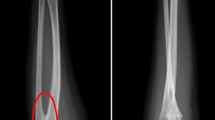Abstract
A 10 year prospective study of 14 patients with mixed gonadal dysgenesis (MGD) and six patients with dysgenetic male pseudohermaphroditism (DMP) is reported. All of them had internal mullerian structures, along with unilateral or bilateral dysgenetic testes, ambiguous external genitalia. Twelve had been brought up as male, nine of whom had a unilateral descended testis. Eight had been reared as females, as they had bilaterally undescended gonads, and ambiguous genitalia. Clinical examination, retrograde genito-urethrography and cytogenetic studies suggested the diganosis in 16 patients, while four were diagnosed on inguino-abdominal exploration for undescended testis. This report delineates more clearly the clinical profile of these orders.
All the patients reared as male were assigned the male gender following abdominal gonadectomy, retention of scrotal testis and male genitoplasty. The eight patients who were reared as females underwent bilateral salpingo-gonadectomy and female genitoplasty. This management differs from the usual recommendation that all such children should be reared as females.
Ten patients (50%) had maternal history of previous abortion/stillbirth, or drug intake in the first trimester of pregnancy suggesting a role of these factors in the etiology. All cases of DMP had a 46, XY karyotype, while eight of 14 cases of MGD had mosaicism with 45X/46,XY cell lines in blood or gonadal cultures. The clinicopathological features of patients of MGD and DMP were similar. It is suggested that these two disorders represent different spectra of the same disorder. A unifying concept of etiopathogenesis is proposed.
Similar content being viewed by others
References
Rajfer J, Walsh PC. Mixed gonadal dysgenesis-dysgenetic male pseudohermaphroditism, In: Josso N, ed. The Intersex Child.Pediatr Adolesc Endocr, 1981; Vol 8. Basel, Karger, pp. 101–115.
Rajfer J, Mendelsohn G, Arnheim J et al. Dysgenetic male pseudohermaphroditism.J Urol 1978; 119: 525–527.
Zäh W, Kalderon AE, Tucci JR. Mixed gonadal dysgenesis.Acta Endocr Copenh suppl 1975; 197: 3–39.
Jirasek JE. Testicular dygenesis syndromes.Brith Defects 1971; 7: 159–165.
Bergada C, Cleveland WW, Jones HW Jr et al. Gonadal histology in patients with male pseudohermaphroditism and atypical gonadal dysgenesis: relation to theories of sex differentiation.Acta Endocr Copenh 1962; 40: 493–520.
Robboy SJ, Miller T, Donahoe PK et al. Dysgenesis of testicular and streak gonads in the syndrome of mixed gonadal dysgenesis.Hum Pathol 1982; 13: 700–716
Davidoff F, Federman DD. Mixed gonadal dysgenesis.Pediatrics 1973; 52: 727–747.
Chemke J, Carmichael R, Stewart JM et al. Familial XY gonadal dysgenesis.J. Med Genet 1970; 7: 105–111.
Federman DD.Abnormal Sexual Development. A Genetic and Endocrine Approach to Differential Diagnosis. Philadelphia: W.B. Saunders and Co., 1967.
Sohval AR. Mixed gonadal dysgenesis: a variety of hermaphroditism.Am J Hum Genet 1963; 15: 155–158.
Aarskog D. Intersex conditions masquerading as hypospadias.Birth Defects 1971; 7: 122–130.
Rohatgi M, Menon PSN, Verma IC et al. The presence of intersexuality in patients with advanced hypospadias and undescended gonads.J Urol 1987; 137: 263–267.
Sinclair AH, Berta P, Palmer MS et al. A gene from the human sex determining region encodes a protein with homology to a conserved DNA—binding motif.Nature 1990; 346: 240–244.
Iyenger JK, Rohatgi M, Menon PSN et al. Clinical, cytogenetic and hormonal profile in extreme hyposadias with bilatcrally descended testes.Indian J Med Res 1986; 83: 604–609.
Lee PA, Mazur T, Davish R et al. Micropenis. I Criteria, etiologies and classification.Johns Hopkins Med J 1980; 146: 156–163.
Gubbay J, Collignon J, Koopman P et al. A gene mapping to the sex determining region of the mouse Y chromosome is a member of a novel family of embryonically expressed genes.Nature 346: 245–250.
McLaren A, Simpson E, Tomonari K et al. Male sexual differentiation in mice lacking H-Y antigen.Nature 1984; 312: 552–555.
Rajfer J, Walsh PC. The incidence of intersexuality in patients with hypospadias and cryptorchidism.J Urol 1976; 116: 769–770.
O'Rahilly R. The development of vagina in the human. In: Blandau and Bergsma, eds.Morphogenesis and Malformation of the Genital System. New York; Liss, 1977; pp. 123–136.
van Niekerk WA. True hermaphroditism. In: Josso N, ed.The Intersex Child. Pediatr Adolesc. Endocr. Basell Karger 1981; Vol. 8: pp 80–99.
Mistal M, Pamiagua R, Lcon L et al. Ectopic seminiferous tubules in the tunica albuginea of normal and dysgenetic testes.Appl Pathol 1985; 3: 123–128.
Donahoe PK, Crawford JD. Ambiguous genitalia in the newborn, In: Welch JK, Randolph J, Ravitch MM, O'Neil JA, Rowe IM, eds.Pediatric Surgery, chapter 139, Vol 2, Chicago, London; Year Book Medical Publishers Inc., 1986: pp 1372–1376.
Scully RE. Neoplasia associated with anomalous sexual development and abnormal sex chromosomes. In: Josso N, ed. The Intersex Child,Pediatr Adolesc Edocr: Basel, Karger 1981; Vol. 8: pp 203–217.
Author information
Authors and Affiliations
Additional information
This article is based on the presentation in the “International Workshop on Recent Advances in Neonatal Surgery and Intersex Disorders” held at All India Institute of Medical Sciences, New Delhi from March 1–4, 1989.
Rights and permissions
About this article
Cite this article
Rohatgi, M., Gupta, D.K., Menon, P.S.N. et al. Mixed gonadal dysgenesis and dysgenetic male pseudohermaphroditism—A critical analysis. Indian J Pediatr 59, 487–500 (1992). https://doi.org/10.1007/BF02751566
Issue Date:
DOI: https://doi.org/10.1007/BF02751566




